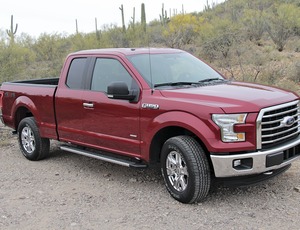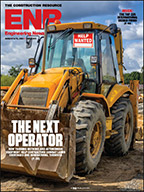

Pulling up to a stoplight in Tucson, I had my first taste of Ford's new fuel diet. After the 2015 F-150 came to a stop, the engine shut down, and the air-conditioning fan receded from a flurry to a whisper. That's when it hit me: The lightweight aluminum body is just a carrier for current—and future—fuel-saving technology.
The new body has received much attention. The F-150 is America's most produced vehicle—car or truck. For years, Ford has used aluminum in the hood, but the light metal has been, until now, mainly available for speciality applications. The F-150 chassis is made of higher-strength steel, which also saves weight.
Forgetting that the optional 2.7-liter V6 Ecoboost engine includes automatic stop-start, it took me by surprise when the truck shut down like a golf cart. A console switch allowed me to override it, and I discovered that nudging the fan controls also forced the motor to click back on. As this was a mild morning in May, I decided to let it be. Doing so translated into a 5% to 7% boost in fuel economy, or roughly 1 to 2 miles per gallon, AAA estimates.
After logging 150 miles in and around Tucson, the truck's computer registered 19 miles per gallon, within the window sticker's estimate of 18 mpg in city and 23 mpg on highway. I calculated 17.5 mpg when filling up—still not bad for a short stint in an extended-cab, four-wheel-drive pickup with a 3.55 rear axle. A two-wheel-drive version with the same engine delivers the F-150's highest rating, at 19/26 mpg.
The new 2.7-liter also surprised me with its giddy-up. Rated at 325 horsepower and 375 lb-ft of torque and mated to an across-the-line six-speed automatic transmission, the little V6 is a solid performer for daily tasks. It also uses a new cartridge-style oil filter, mounted right on top of the engine for easy access.
Base price is a competitive $26,995, including delivery fees. Standard is a 282-hp, 3.5-liter V6; the optional 2.7-liter costs an additional $795. Users needing more pulling power can opt for the 365-hp, 3.5-liter V6 EcoBoost or the 385-hp, 5.0-liter V8 engine. For 2016, Ford soon will offer a compressed natural-gas prep kit for the V8. Before discounts, my test truck was priced at $45,475.
Inside, the mid-level XLT cab provided plenty of legroom, supportive seating and storage space. The extended cab sat five easily, but, for long trips, the people who rode in back said they would have preferred the extra legroom of a crew cab. Fit and finish was excellent all around. If this is what dieting feels like, sign me up.
The new F-150 is "quieter and handles better," reports Bryan Bassett, executive vice president of Flex Fleet Rental, which runs the 3.5-liter EcoBoost. Fuel economy is less than expected but still "very good," he notes. Ford designed the body modularly for easy repairs and expects cost of ownership "will remain similar to or less than today's levels," says Mike Levine, spokesman. In case of damage, Consumer Reports advises using Ford-certified body shops for the best rates.



Post a comment to this article
Report Abusive Comment